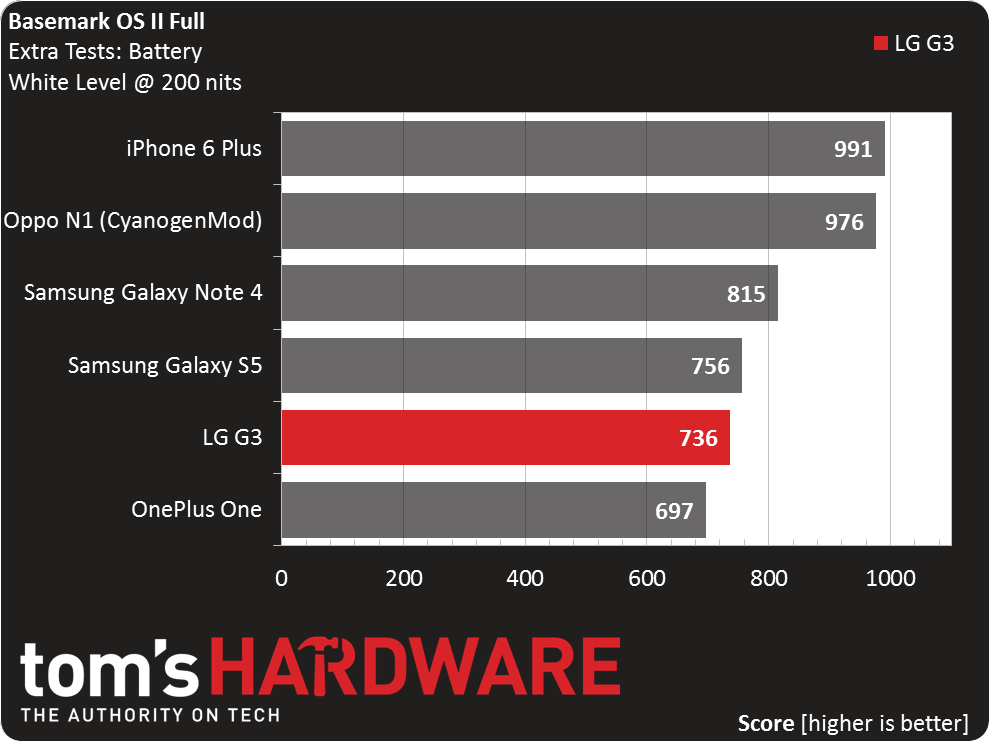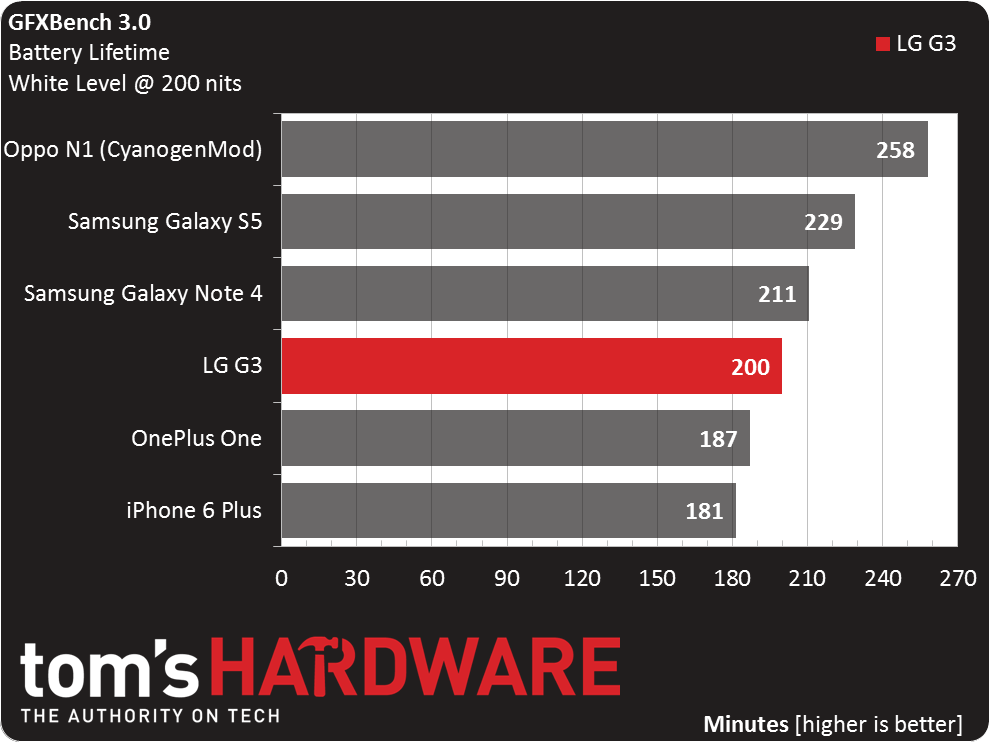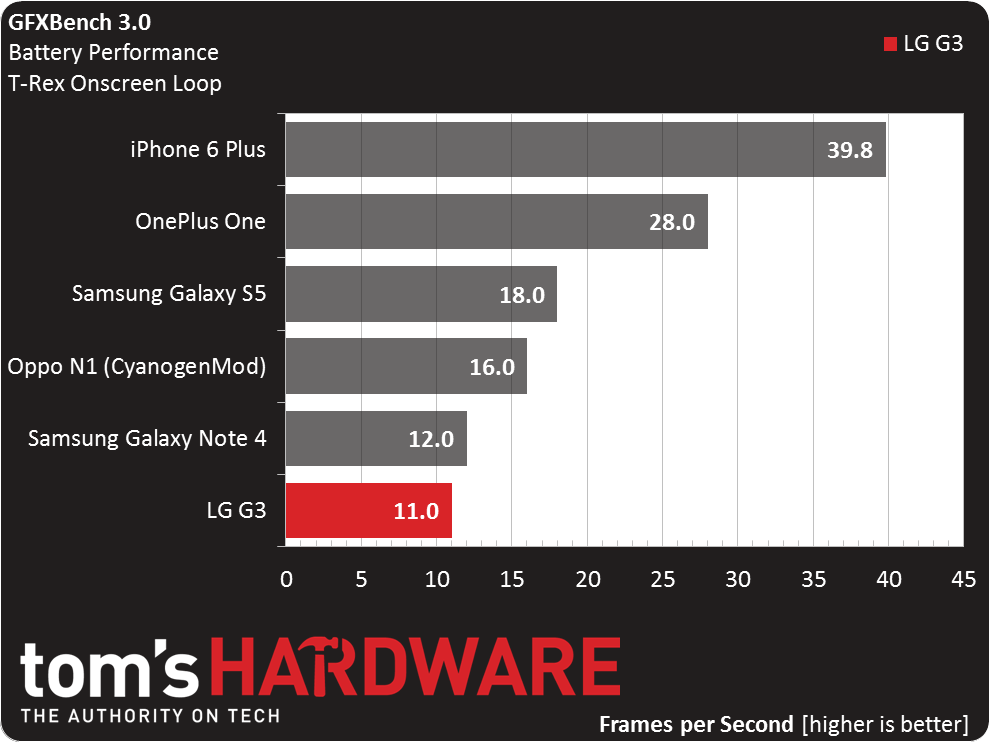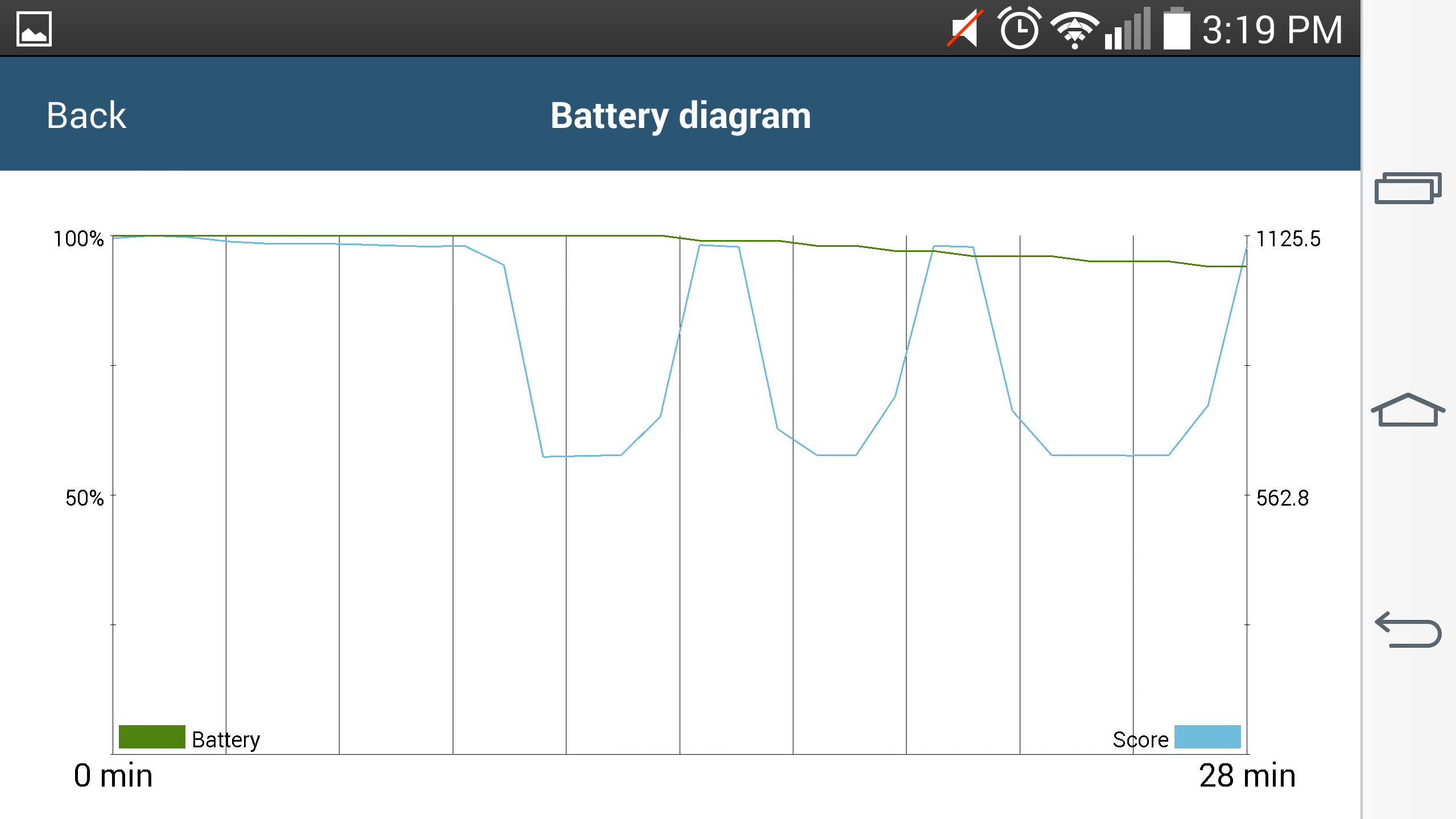LG G3 Smartphone Review: A Plethora Of Pixels And A Laser!
The LG G3 combines cutting-edge hardware, including a 5.5-inch WQHD screen and laser autofocus system, with a lightweight body and slim bezels to create a phone that was ahead of its time. Is it still worth your consideration? Read on for our impressions.
Why you can trust Tom's Hardware
Results: Battery And Throttling
Basemark OS II Full (Anti-Detection)
The Basemark OS II battery test scores are derived by repeatedly running the devices until enough data has been collected to determine the drain rate of the device.
Of the two WQHD devices, the Note 4, with a 7% larger battery and slightly larger screen, manages to score 11% better than the G3. It’s not a big difference, but also not insignificant considering the Snapdragon 805 in the Note 4 offers better performance on the same 28nm HPm process as the 801 in the G3.
The iPhone 6 Plus and its smaller 2906mAh battery scores 35% better than the G3 with a 3000mAh battery. The 3610mAh battery in the Oppo N1 helps it score well, despite its slower Snapdragon 600 SoC and less-optimized 28nm LP process.
BatteryXPRT 2014
Unfortunately, we couldn’t collect any data for BatteryXPRT 2014. The test repeatedly crashed on the G3 and never ran to completion.
GFXBench 3.0 Corporate
GFXBench's battery test measures battery life and performance stability by logging frame and battery discharge rate as the on-screen T-Rex test runs for 30 consecutive iterations. The results are given in two scores: estimated battery life in minutes and the number of frames rendered on the slowest test run (to gauge if a device is throttling).
The G3 falls behind the Galaxy S5 and Note 4 in battery life, but still lasts a reasonable 3.3 hours.
If we only look at the battery life chart, we might conclude that the G3 is superior to the iPhone 6 Plus. However, the iPhone completes the test at peak performance without any throttling. This, unfortunately, is not the case for the G3.
Get Tom's Hardware's best news and in-depth reviews, straight to your inbox.
Average performance over thirty iterations of T-Rex drops to 11 FPS compared to 20 FPS for a single iteration. The diagram below shows how the G3’s performance varies over time.
The G3 is unable to dissipate the heat generated from running the GPU at 100% and has to throttle the GPU clock speed to keep it within its thermal envelope. This is one disadvantage of using an all-plastic construction.
Current page: Results: Battery And Throttling
Prev Page Results: Display Measurements Next Page Better To Be Fashionably Late Then Impatiently Early-
Vorador2 At this point, i wouldn't bother. Rumors have surfaced than a successor will be launched in March.Reply
Tom's, you're almost at the point of self-parody. I would rename the site to "The Slowest Authority on Tech" -
wtfxxxgp For once I must agree that THW has dropped the ball on a very important phone review - it was too late - and the "better late than never" gesture never applies to a Review of something. My sister has just purchased this phone a week ago, had I had sight of a THW review then I'm sure I could have convinced her to rather wait for the next model that would surely have better support for that gorgeous screen - I played with it, it really is amazing watching video on that thing.Reply -
zodiacfml It's quite late and learned little except the voice activated shutter feature. Most of the information are subjective and benchmarks are quite of little use since the database is quite few.Reply
Tom's, here is a suggestion. Since you're good with gaming benchmarks, why not just make reviews of smartphones as portable gaming machines? There's plenty of information to be gathered from such and plenty of debates/discussion could be created just from that.
Build a database of old games and phones to be compared to new devices. Higher benchmark numbers encourages upgrades (*wink*). -
Cryio Absolutely no Lumia in the photo shoot comparison? I thought. A Lumia 1020 or Lumia 930 with Denim should have photo sampling comparisons in the next list. Also an iPhone 6+.Reply -
bujcri Suprised not to be mentioned about LG's Lollipop update for LG G3. At least worth mentioning that this update pretty much ruined some funtions on G3 like silent mode (now DND) and brought a lot of useless notifications on lockscreen like for example whatever you wanna have permanently on the notification bar (I used to have the date there). In a nutshell I really hate Lollipop.Reply -
kiniku I sold this phone on Ebay and bought a Sony Xperia Z3. I went from 8-10 hours of battery life to 48+, brighter screen, water resistant, and amazing sound.Reply -
glasssplinter I had to look at this article several times to confirm that you really just published this. New phone models are just around the corner and you're barely pushing this article out. Why did you feel the need to compare so many features to crapple tech also? The whole reason I'm interested in the phone is because it isn't crapple so people don't care how it stacks up. We want to know how it compares to other android phones. It's like putting the newest icrap review out and then saying but the icrap 10 still doesn't have a removable battery but this android and windows phone does in some hope of swaying them. Tom's has hit new lows...you would have been better off just not publishing this.Reply -
MobileEditor ReplyMan! I can't wait for the new Samsung Galaxy S4 review!
Don't buy it. Review done :)
- Matt H.



